steering wheel SSANGYONG TURISMO 2013 Service Manual
[x] Cancel search | Manufacturer: SSANGYONG, Model Year: 2013, Model line: TURISMO, Model: SSANGYONG TURISMO 2013Pages: 796, PDF Size: 78.99 MB
Page 419 of 796
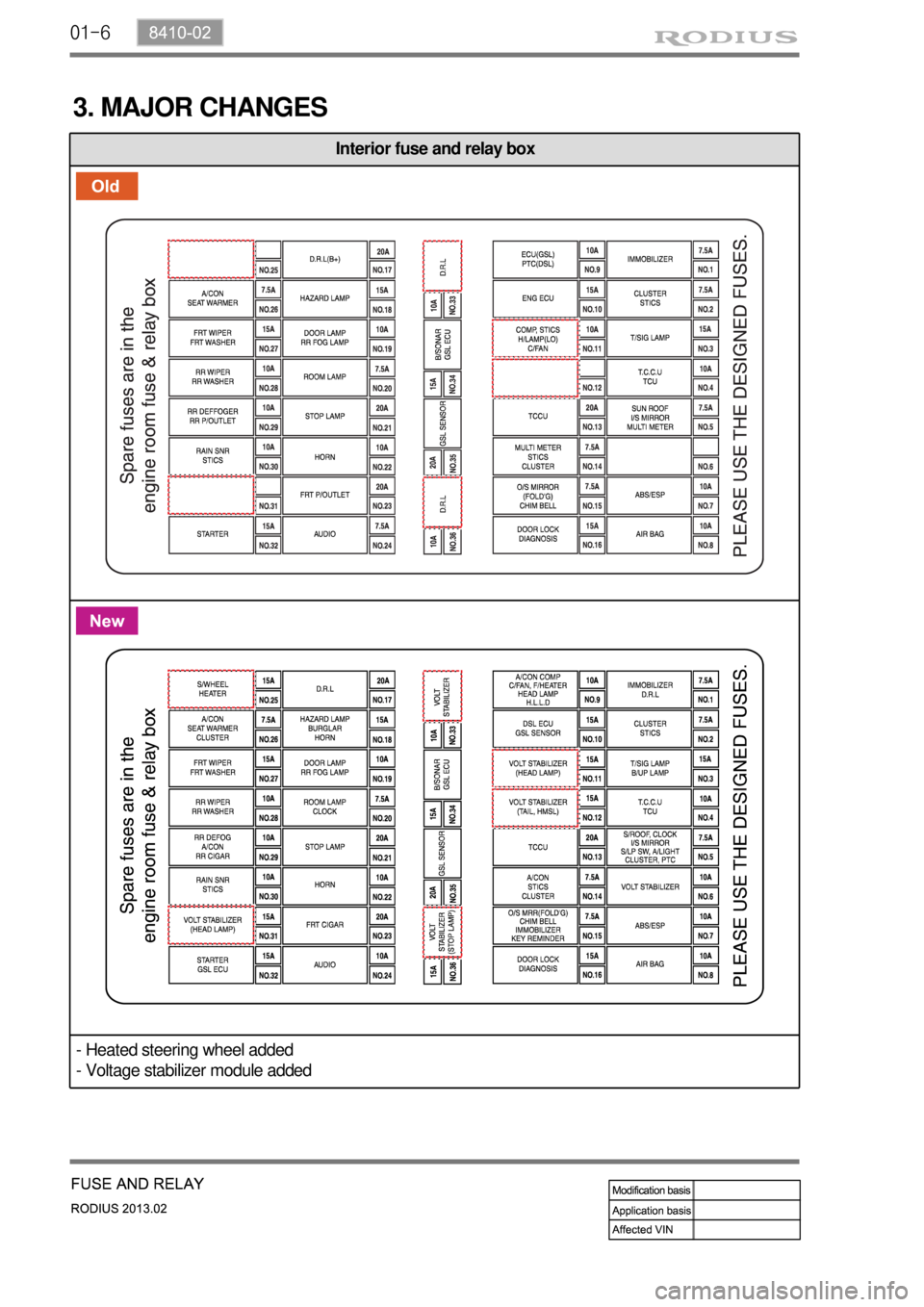
01-6
3. MAJOR CHANGES
Interior fuse and relay box
- Heated steering wheel added
- Voltage stabilizer module added
Page 503 of 796

06-38510-00
1. SPECIFICATIONS
1) Center Fascia Switch
Item Specifications
Center fascia switch &
bezel assemblyHazard warning flasher switch DC 12 V 10 A(lamp load)
Windshield heated glass switch
DC 12 V 1 A(inductive load) Rear heated glass switch
ESP OFF switch
Driver/front passenger seat warmer
switch
Fog lamp switch
2) 4WD Switch & HLLD Switch & Rear Wiper Operation Switch
Item Specifications
4WD switch &
HLLD switch &
rear wiper operation
switch assemblyWasher switch DC 12 V 3.8 A(lamp load)
Wiper switch DC 12 V 3.0 A (max. 10 A)
4WD switch DC 12 V 300 mA
HLLD switch DC 12 V 1 A (inductive load)
3) Steering Wheel Switch
Item Specifications
Steering wheel switch Rated voltage DC 5 V 0.1 A(rated load)
Operation temperature-30℃~+80℃
Page 505 of 796

06-58510-00
2. MAJOR CHANGES
Center fascia switch
- Design changed
Steering wheel switch assembly
- Power button deleted, steering wheel heating (option) switch added
- Design changed
Multifunction switch assembly
- Connector pin layout changed due to newly added steering wheel heating (option) circuit
- Contact coil and steering wheel angle sensor changed
Page 508 of 796
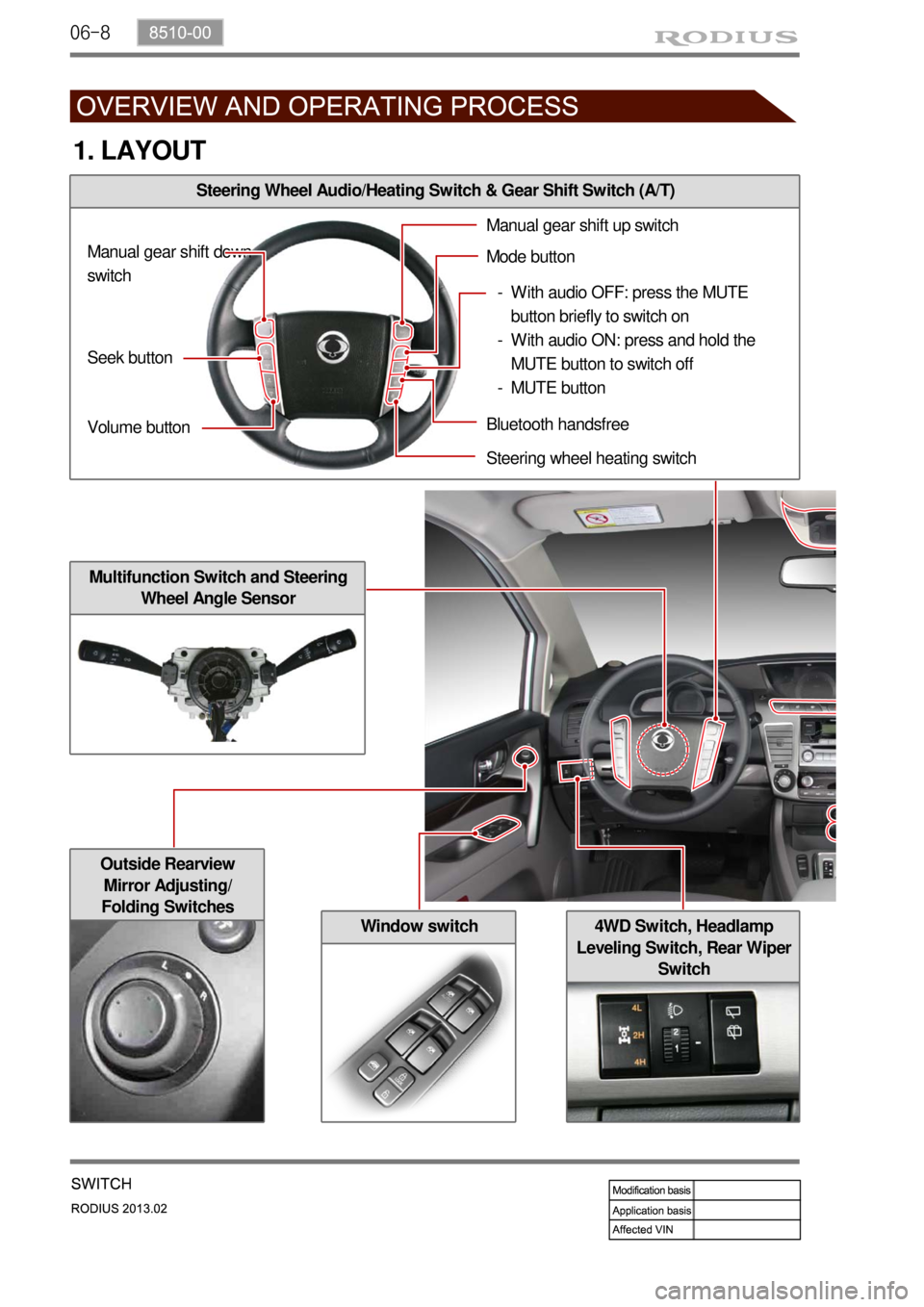
06-8
Outside Rearview
Mirror Adjusting/
Folding Switches
Window switch
Steering Wheel Audio/Heating Switch & Gear Shift Switch (A/T)
Multifunction Switch and Steering
Wheel Angle Sensor
4WD Switch, Headlamp
Leveling Switch, Rear Wiper
Switch
1. LAYOUT
Seek button
Volume button Manual gear shift down
switchManual gear shift up switch
Mode button
Bluetooth handsfree
Steering wheel heating switch
With audio OFF: press the MUTE
button briefly to switch on
With audio ON: press and hold the
MUTE button to switch off
MUTE button -
-
-
Page 542 of 796
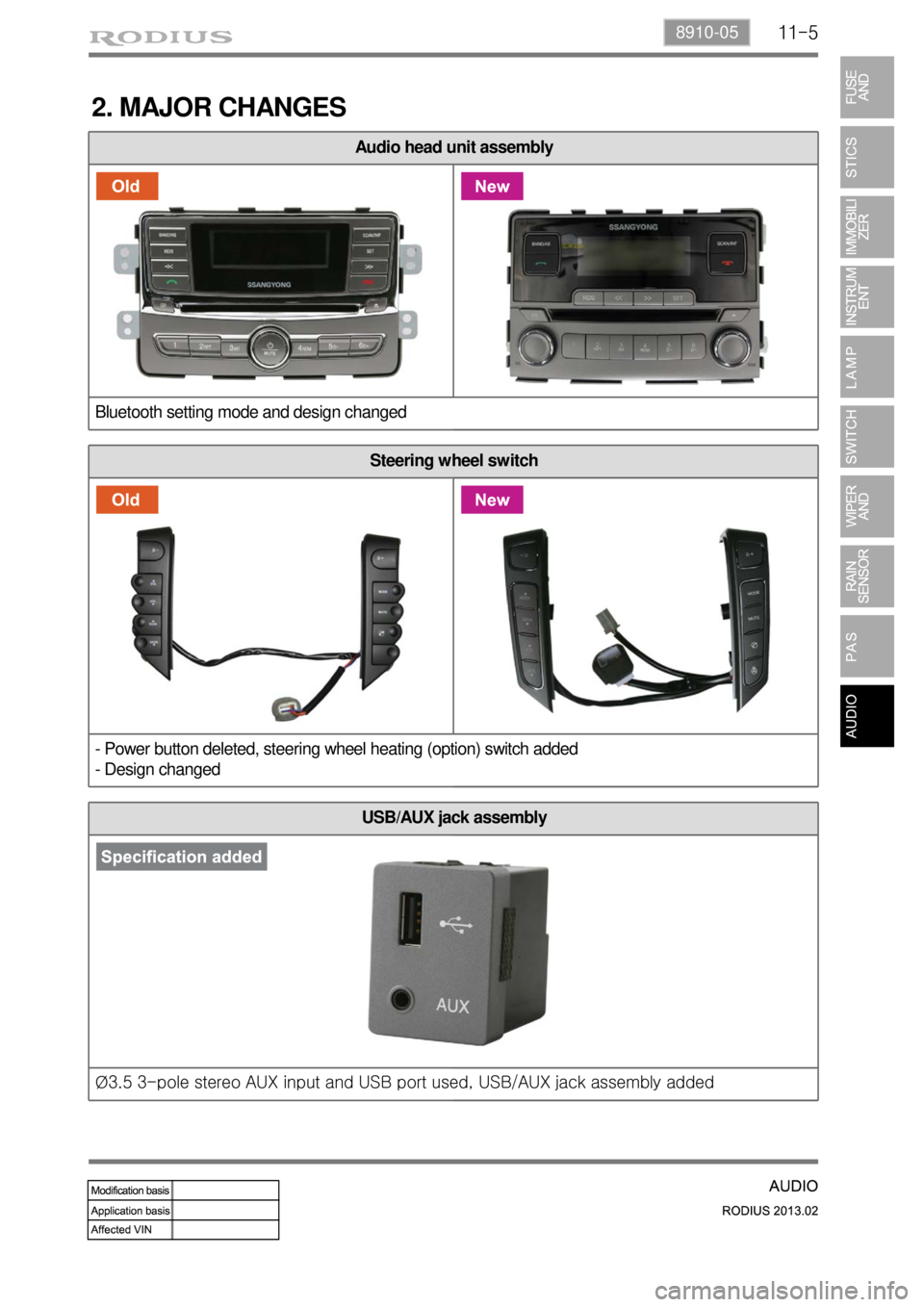
11-58910-05
Audio head unit assembly
Bluetooth setting mode and design changed
Steering wheel switch
- Power button deleted, steering wheel heating (option) switch added
- Design changed
2. MAJOR CHANGES
USB/AUX jack assembly
Ø3.5 3-pole stereo AUX input and USB port used, USB/AUX jack assembly added
Page 545 of 796
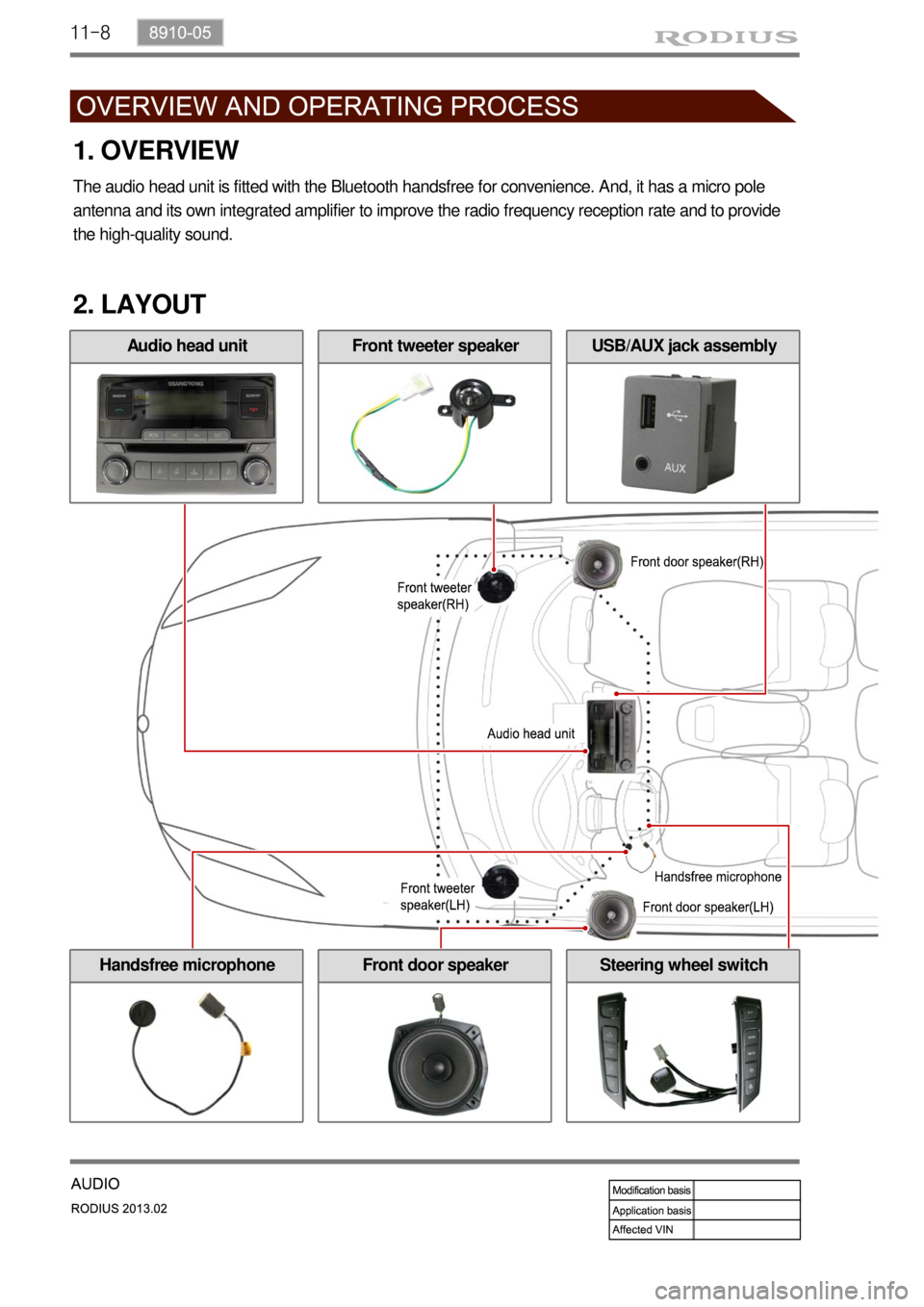
11-8
Front door speaker
2. LAYOUT
Handsfree microphoneSteering wheel switch
1. OVERVIEW
The audio head unit is fitted with the Bluetooth handsfree for convenience. And, it has a micro pole
antenna and its own integrated amplifier to improve the radio frequency reception rate and to provide
the high-quality sound.
Audio head unitFront tweeter speakerUSB/AUX jack assembly
Page 546 of 796
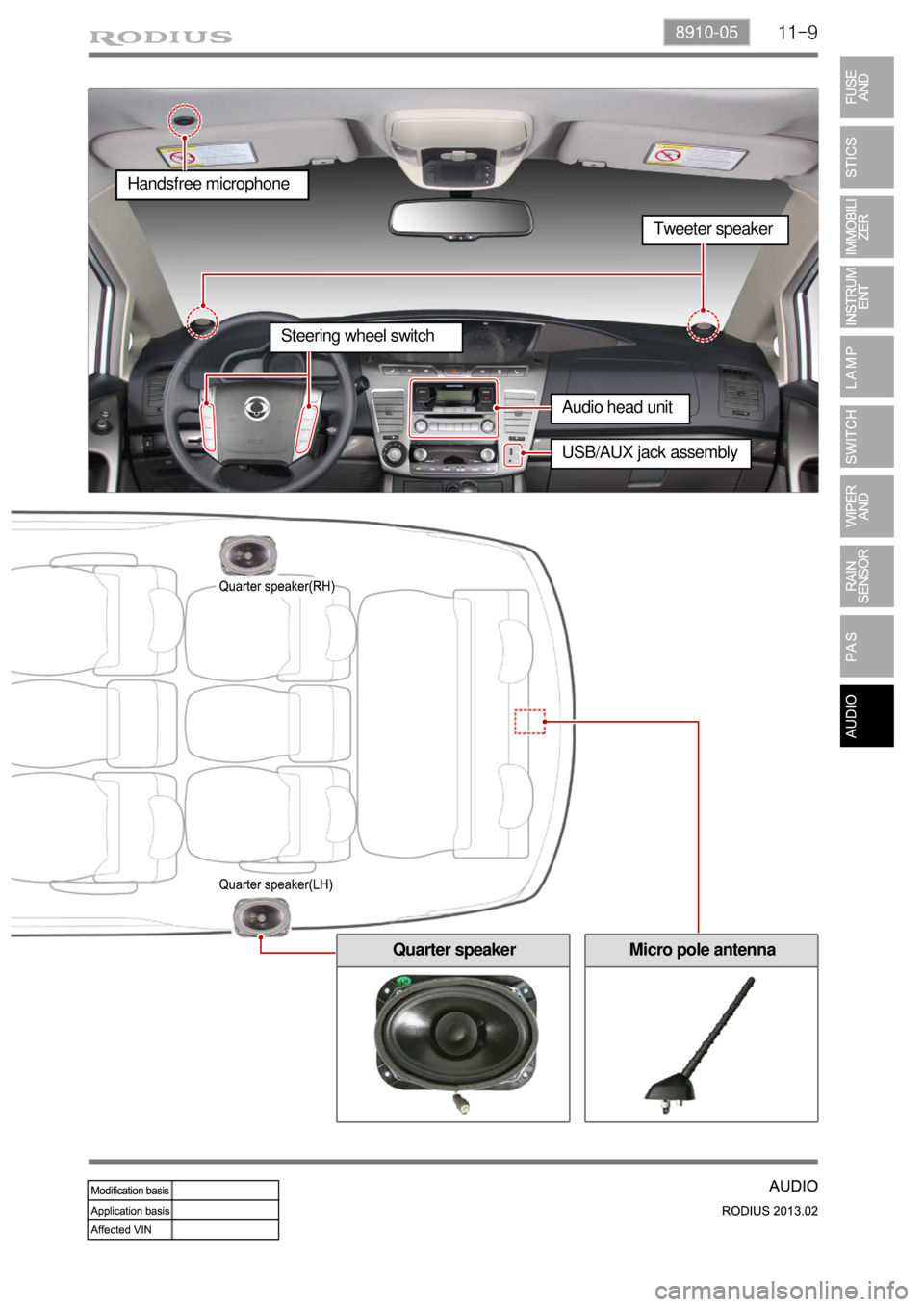
11-98910-05
Micro pole antennaQuarter speaker
Handsfree microphone
Tweeter speaker
Audio head unit
Steering wheel switch
USB/AUX jack assembly
Page 547 of 796
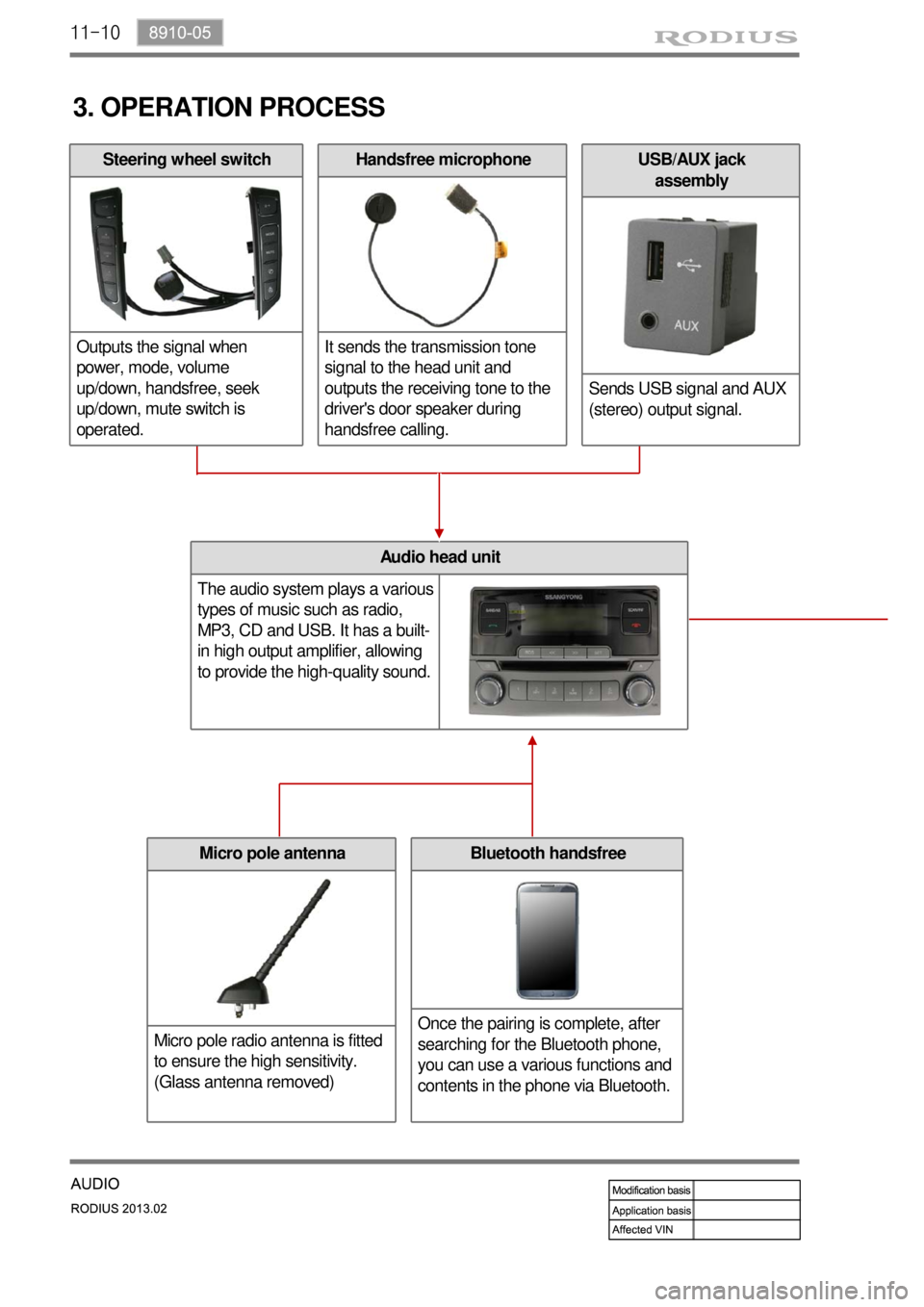
11-10
USB/AUX jack
assembly
Sends USB signal and AUX
(stereo) output signal.Handsfree microphone
It sends the transmission tone
signal to the head unit and
outputs the receiving tone to the
driver's door speaker during
handsfree calling.Steering wheel switch
Outputs the signal when
power, mode, volume
up/down, handsfree, seek
up/down, mute switch is
operated.
3. OPERATION PROCESS
Audio head unit
The audio system plays a various
types of music such as radio,
MP3, CD and USB. It has a built-
in high output amplifier, allowing
to provide the high-quality sound.
Micro pole antenna
Micro pole radio antenna is fitted
to ensure the high sensitivity.
(Glass antenna removed)Bluetooth handsfree
Once the pairing is complete, after
searching for the Bluetooth phone,
you can use a various functions and
contents in the phone via Bluetooth.
Page 627 of 796

07-12
3. WHEEL ALIGNMENT
Wheel alignment (adjustment of Camber, Caster and Toe) is part of standard automobile maintenance
that consists of adjusting the angles of the wheels so that they are set to the specification. The purpose
of these adjustments is to reduce tire wear, and to ensure that vehicle travel is straight and true (without
"pulling" to one side). Alignment angles can also be altered beyond the specifications to obtain a specific
handling characteristic.
When viewed from the top, the distance between the tire centers is smaller in the front than in
the rear. ▶
Side slip protection
Parallel front wheels rotation (straight ahead driving is ensured by toe-in to prevent the wheels from tilting
outwards by the camber while driving)
Prevention of uneven (outward) tire wear Prevention of toe-out from wearing of steering linkage -
-
-
1) Toe-in
The difference of measured distances between the front ends of the tires (A) and the rear ends of the
tires (B) along the same axle when viewed the wheels from the top.
Toe-inFront0.˚±0.10˚
Rear0.48˚±0.15˚
Necessity for Wheel Alignment ▶
Wheel alignment consists of adjusting the angles of the wheels so that they are perpendicular to the
ground and parallel to each other. The purpose of these adjustments is maximum tire life and a vehicle
that tracks straight and true when driving along a straight and level road.
The symptoms of a vehicle that is out of alignment are:
Uneven or rapid tire wear
Pulling or drifting away from a straight line
Wandering on a straight level road
Spokes of the steering wheel off to one side while driving on a straight and level road.
Page 628 of 796
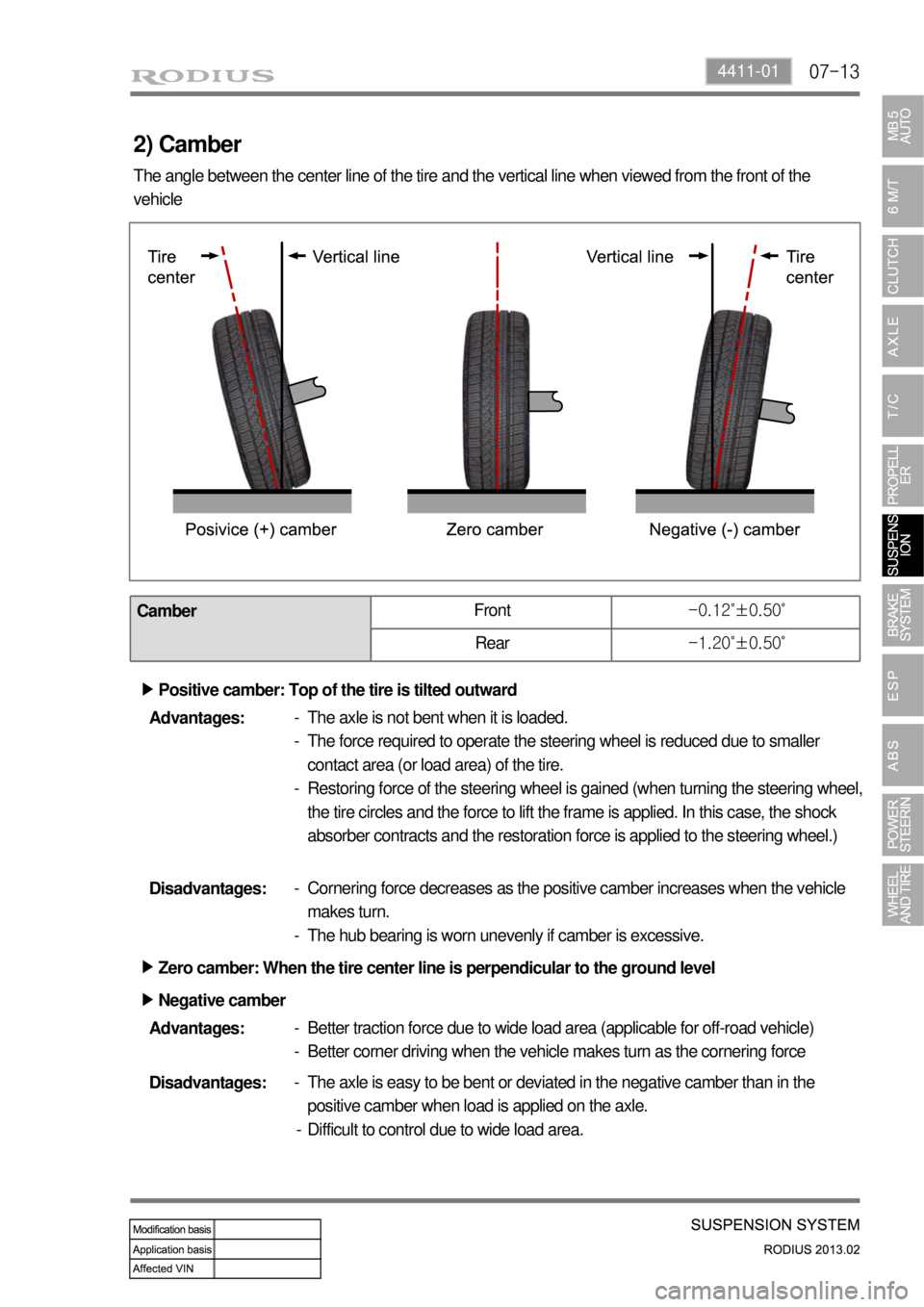
07-134411-01
2) Camber
The angle between the center line of the tire and the vertical line when viewed from the front of the
vehicle
CamberFront-0.12˚±0.50˚
Rear-1.20˚±0.50˚
Zero camber: When the tire center line is perpendicular to the ground level ▶
Disadvantages:The axle is easy to be bent or deviated in the negative camber than in the
positive camber when load is applied on the axle.
Difficult to control due to wide load area. -
- Advantages:Better traction force due to wide load area (applicable for off-road vehicle)
Better corner driving when the vehicle makes turn as the cornering force -
- Negative camber ▶Disadvantages:Cornering force decreases as the positive camber increases when the vehicle
makes turn.
The hub bearing is worn unevenly if camber is excessive. -
- Advantages:The axle is not bent when it is loaded.
The force required to operate the steering wheel is reduced due to smaller
contact area (or load area) of the tire.
Restoring force of the steering wheel is gained (when turning the steering wheel,
the tire circles and the force to lift the frame is applied. In this case, the shock
absorber contracts and the restoration force is applied to the steering wheel.) -
-
- Positive camber: Top of the tire is tilted outward ▶